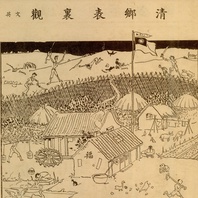
Item
Qingxiang biaoli guan (Within and beyond Rural Pacification)
In this artistic representation of a village which has undergone Rural Pacification, peasants are shown going about their business within the walls of a “pacified” village. Outside the village walls, resistance fighters starve to death and inflict violence upon local residents. The image is taken from the periodical Zhongguo manhua (Chinese Cartoons) 2.1 (October 1942). This was the house magazine of the Chinese Cartoon Associations (Zhongguo Manhua Xiehui).
Read More
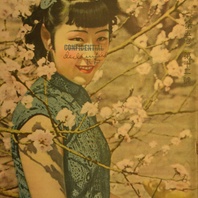
Item
Xin Zhonghua huabao (New China Pictorial) cover, December 1943
This cover image from the Xin Zhonghua huabao (New China Pictorial) 5.12 (December 1943) shows a colourised photograph of an unidentified “modern girl”. The New China Pictorial was a bilingual (Chinese-English) magazine published from 1939 through 1944 in Shanghai by the occupation journalist Wu Linzhi for distribution in China and throughout Southeast Asia.
Read More
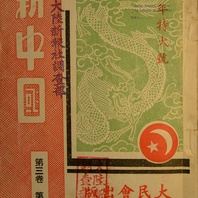
Essay
The Daminhui: A propaganda agency in occupied China
Unattributed and untitled image of two Chinese children (one wearing an armband with the Daminhui logo in it) from a 1940 Daminhui propaganda publication. The Daminhui (lit., “Great People’s Association”) was organised by the Japanese special service in Shanghai in 1938,[1] but was officially directed by the veteran Kuomintang member Wen Zongyao in Japanese-occupied east and central China.[2] It has been described as the “flagship enterprise of the Reformed Government [of the ROC].”[3] The Daminhui was responsible for a variety of propaganda work, and learnt its skills directly from propaganda organisations in north China, especially the Xinminhui. Within the Daminhui’s Propaganda Department worked Chinese graphic artists, journalists, dramatists, and activists. The Daminhui made a particular name for itself in mobilizing local communities for pro-occupation celebrations.[4] The cover of the Daminhui house publication Xin Zhongguo (New China) Much of the propaganda work undertaken by the Daminhui (and reproduced in its house pictorials like New China) looked remarkably similar to the “salvationist” (jiuguo) propaganda that had been developed by the Chinese resistance in Wuhan in 1938.[5] This was because a number of the Daminhui’s affiliated agencies were specifically designed to emulate what the Japanese saw as effective methods of persuasion developed by the Chinese resistance early in the war. Nonetheless, the Daminhui developed its own “brand.” It operated under a logo comprised of a five-pointed star and a crescent moon. The influence of the Daminhui would continue to be felt in occupied east China through until 1945, as many of its members joined the ranks of Wang Jingwei’s government at its formation in 1940. Revellers at the founding of Wang Jingwei’s Reorganised National Government in March 1940 wave the Daminhui flag. [1] T’ien-wei Wu, “Contending political forces during the War of Resistance,” in China’s Bitter Victory: The War with Japan, 1937-1945, eds., James C. Hsiung and Steven I. Levine (Armonk, NY: East Gate, 1992) , 66–67. [2] Wen Zongyao, “Daminhui Wen huizhang gao minzhong shu” [Letter from Director Wen of the Daminhui to the people], Xin Zhongguo 2, no. 11–12 (December 1939): 2–3. [3] Timothy Brook, “Occupation state building,” in China at War: Regions of China, 1937–1945, eds. Stephen R. MacKinnon, Diana Lary and Ezra F. Vogel (Stanford, CA: Stanford University Press, 2007), 35. [4] Liu Jie, “Kangzhan chuqi Huadong lunxianqu qin-Ri qunti yanjiu: yi Daminhui Zhenjiang lianhe zhibu wei zhongxin de tantao” [A study of pro-Japanese groups in occupied areas of east China in the early stages of the War of Resistance: A discussion of the Daminhui’s branch office in Zhenjiang], Zhongyang yanjiuyuan jindaishi yanjiusuo jikan 98 (2017): 89–114. [5] As detailed in Stephen R. MacKinnon, War, Refugees, and the Making of Modern China: Wuhan, 1938 (Berkeley, CA: University of California Press, 2008).
Read More
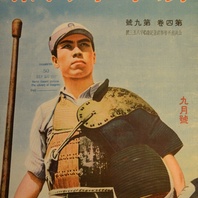
Item
Xin Zhonghua huabao (New China Pictorial) cover, September 1942
This cover image from the New China Pictorial 4.9 (September 1942) shows an unnamed member of the Chinese collaborationist forces in the outfit of a kendoka. There is little to identify this image (almost certainly created by the news agency Dōmei, as it was used as the cover image for the Japanese-language Dōmei Graph in October 1942) as being of a Chinese man, other than the inclusion of the Nationalist Chinese (white sun) insignia on his cap. The same image was used in later propaganda celebrating the collaborationist government’s declaration of war on the Allies. This was the only cover image from this magazine which included a male figure. The New China Pictorial was a bilingual (Chinese-English) published from 1939 through 1944 in Shanghai by the occupation journalist Wu Linzhi for distribution in China and throughout Southeast Asia.
Read More
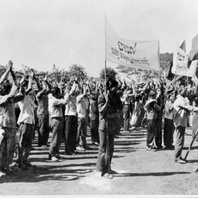
Featured Item
Crowd celebrating the Kampuchea United Front for National Salvation
This photograph shows people cheering the programme of the Kampuchea United Front for National Salvation (KUFNS, also known as FUNSK) [Front or Renakse]. It may have been taken in Kratie on 2 December 1978. It was featured in the publication (French and English versions) entitled The People’s Republic of Kampuchea (1979). This photograph is part of the collection held by the Agence Khmère de Presse (AKP) and Cambodia’s Ministry of Information. This collection, which documents the early years of the People’s Republic of Kampuchea as photographed by the Vietnamese and a small team of Cambodian photographers, has not yet been classified or indexed.
Read More
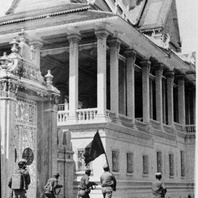
Featured Item
Troops advancing on the Royal Palace
This picture shows troops of the Kampuchea United Front for National Salvation (KUFNS, also known as FUNSK) [Front or Renakse] advancing along the Royal Palace during the takeover of Phnom Penh in January 1979. This image was featured in the publication (French and English versions) entitled The People’s Republic of Kampuchea (1979). This photograph is part of the collection held by the Agence Khmère de Presse (AKP) and Cambodia’s Ministry of Information. This collection, which documents the early years of the People’s Republic of Kampuchea as photographed by the Vietnamese and a small team of Cambodian photographers, has not yet been classified or indexed.
Read More
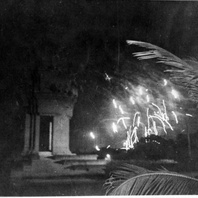
Featured Item
Gunfire near the Independence Monument, Phnom Penh
This image shows firing at night near the Independence Monument during the takeover of Phnom Penh by Vietnamese forces and the troops of the Kampuchea United Front for National Salvation (KUFNS, also known as FUNSK) [Front or Renakse] in January 1979. This photograph is part of the collection held by the Agence Khmère de Presse (AKP) and Cambodia’s Ministry of Information. This collection, which documents the early years of the People’s Republic of Kampuchea as photographed by the Vietnamese and a small team of Cambodian photographers, has not yet been classified or indexed.
Read More
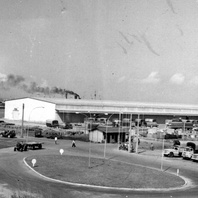
Featured Item
Sihanoukville Seaport
This photograph of Sihanoukville Seaport is part of the collection that was donated to the National Archives of Cambodia from the Library of the Royal University of Fine Arts by Darryl Collins and Helen Grant Ross in 2003. The collection was used by Collins and Ross for their research into urbanisation. The images were probably originally used to mount the Sangkum Reastr Niyum Permanent Exhibition at the Exhibition Hall, Bassac area, Phnom Penh.
Read More
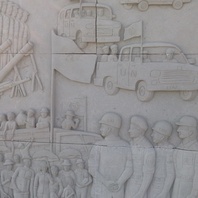
Item
Win-Win Monument bas-relief
This photograph shows details of the UNTAC-themed bas-relief on the 117-metre-long engraved base of the Win-Win Monument, with a focus on UN vehicles and military personnel. The Win-Win Monument complex – photographed here in January 2020 – was inaugurated in December 2018 to mark the twentieth anniversary of the end of the post-Democratic Kampuchea civil war, with the final defection of the remaining Khmer Rouge factions, thanks to the DIFID policy (“Divide, Isolate, Finish, Integrate, Develop”) also known as the “Win Win” policy of Prime Minister Hun Sen.
Read More
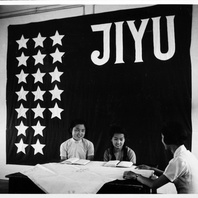
Item
A young Japanese teacher is instructing in Japanese
From a collection of staged photographs produced under the title “Life at a Girls School in Peking”, and produced at the Peking Jiyu Gakuen in Japanese-occupied Beijing. The original caption reads: “This instructor is not very much older than 20 years old [sic]”.
Read More
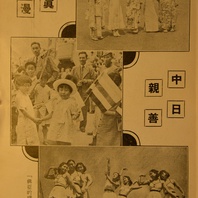
Item
Zhong-Ri qinshan, tianzhen lanman (Sino-Japanese amity, innocent and unaffected)
This series of unattributed photographs is taken from the Daminhui publication Xin Zhongguo (New China) 3.1 (January 1940). They are used here to present scenes of “Sino-Japanese friendship”. In the top two images, Chinese and Japanese children greet each other and waves the flag of Japan and of the Reformed Government of the Republic of China (RGROC). In the image at the bottom of the page, some unnamed performers do an “autumn dance” (qiu wu) entitled “Xing Ya de shuguang” (The light of a revitalized Asia).
Read More
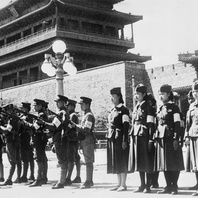
Item
Drill training in Beijing
A group of Chinese male and female police officers attached to the North China Railway Company undergo drill training in Japanese-occupied north China. The city gate behind the group is the Xuanwumen.